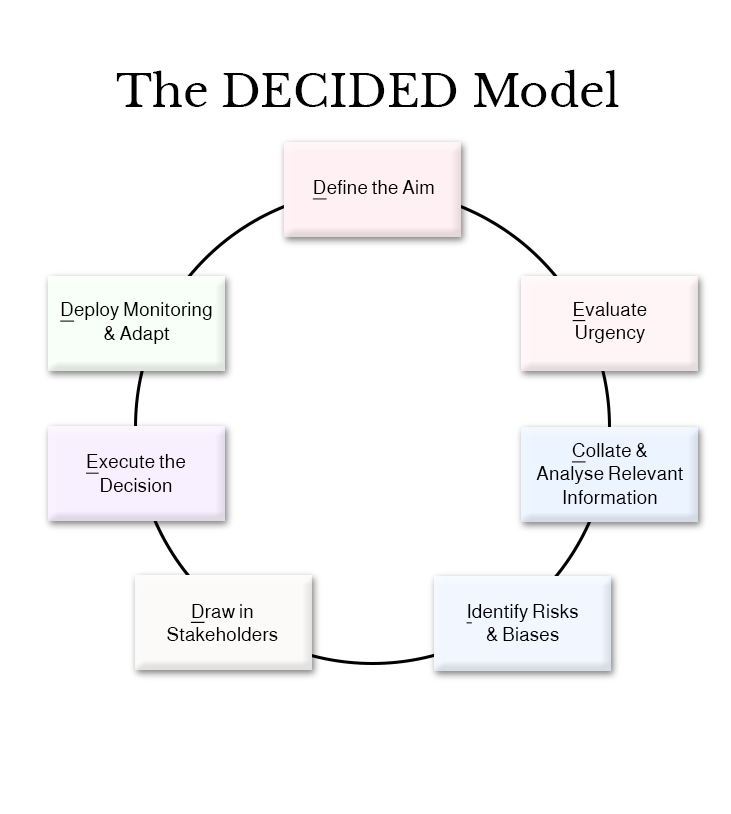The DECIDED Model of Decision Making
The DECIDED Model is a structured cycle designed to guide individuals and leaders through complex choices, alleviating the paralysis many feel when making decisions. Illustrated as a circular flowchart, it outlines seven key steps: Define the Aim, Evaluate Urgency, Collate & Analyse Relevant Information, Identify Risks & Biases, Draw in Stakeholders, Execute the Decision, and Deploy Monitoring & Adapt. This framework ensures a thorough, adaptable process to make impactful decisions that benefit organizations, teams, personal life, and even the broader world.
Understanding the Model:
Structure: The cycle progresses logically:
Define the Aim: Clarify the goal or outcome you want to achieve.
Evaluate Urgency: Assess the time sensitivity and priority of the decision.
Collate & Analyse Relevant Information: Gather and examine data to inform the choice.
Identify Risks & Biases: Spot potential pitfalls and personal or group biases that could skew judgment.
Draw in Stakeholders: Involve key individuals to gain diverse perspectives and buy-in.
Execute the Decision: Implement the chosen action with clear steps.
Deploy Monitoring & Adapt: Track outcomes and adjust as needed, closing the loop.
Purpose: This model tackles decision-making paralysis by providing a comprehensive roadmap. It ensures all critical areas—clarity, timing, data, risks, collaboration, action, and review—are addressed, fostering decisions that create lasting impact.
Holistic Impact: Beyond organizations or teams, it applies to life-changing choices, encouraging a bold, structured approach to influence the world positively.
The DECIDED Model transforms decision-making from a daunting task into a confident, systematic process that offers actionable steps to enhance decision-making:
Set the Goal: Start with Define the Aim—write a clear statement (e.g., “Improve team productivity by 20%”).
Assess Timing: Use Evaluate Urgency to determine deadlines or critical factors (e.g., “Decision needed by September 5, 2025”).
Gather Data: Collate & Analyse Relevant Information by collecting facts, trends, or feedback, then synthesize key points.
Mitigate Risks: Identify Risks & Biases—list potential obstacles (e.g., overconfidence) and plan to counter them.
Engage Others: Draw in Stakeholders by consulting team members or experts, ensuring diverse input by 01:39 PM IST, August 28, 2025, if urgent.
Take Action: Execute the Decision with a detailed plan, assigning roles and timelines.
Review & Adjust: Deploy Monitoring & Adapt—set checkpoints (e.g., weekly reviews) to measure success and tweak the approach.
Team Application: Use in group settings by assigning each step to members, fostering collaboration on complex decisions.
Regular Practice: Apply the cycle to recurring decisions, refining it based on past outcomes.
By following the DECIDED Model, leaders and individuals can overcome hesitation, make informed choices, and drive meaningful change across personal and professional spheres.
